a page by Don Roberson |
 |
||
| Elkhorn Slough enters Monterey Bay at the sleepy fishing village of Moss Landing. Since the building of two rock jetties in 1946, the tidal flow is between the jetties at the harbor mouth (above; that's the Elkhorn Slough Safari pontoon boat and pods of sea otters at the harbor entrance). The entire Elkhorn and Moro Cojo Slough complex is an extremely important tidal estuary for waterbirds in western North America (e.g., American White Pelicans and Marbled Godwits, below). It was one of the first Important Bird Areas (IBAs) in California, and remains one of the best spots in Monterey County. About 320 species have occurred within the IBA; look at a constantly evolving bar graph of species from eBird. | ||
 |
||
| The Moss Landing skyline is dominated by the twin towers of a Duke Energy power plant (see its location in the photo & map below). The photo is taken from Jetty Road looking south over the Moss Landing harbor towards the power plant. A favored gull roost is marked with an "x" on the map, and is the sand flat at the lower left edge of the photo (below). State Hwy 1 cuts through the middle of the map, crossing Elkhorn Slough just north of the power plant and the intersection with Dolan Road. Moss Landing town and marina are south of the harbor entrance at the two jetties. The town and marina, and local businesses, can be very busy with tourists on summer weekends; Hwy 1 itself is a two-lane road with heavy traffic throughout the year. Moss Landing harbor, though, can be birded leisurely from Jetty Road (this is a State Park), or the gull roost scoped from the huge parking areas between the Sea Harvest restaurant and the north harbor marina. The tides affect everything here. At high tide there is no mudflats; at low tide the mudflats are far from the road. The best birding is often at an intermediate state of tide. | ||
|
||
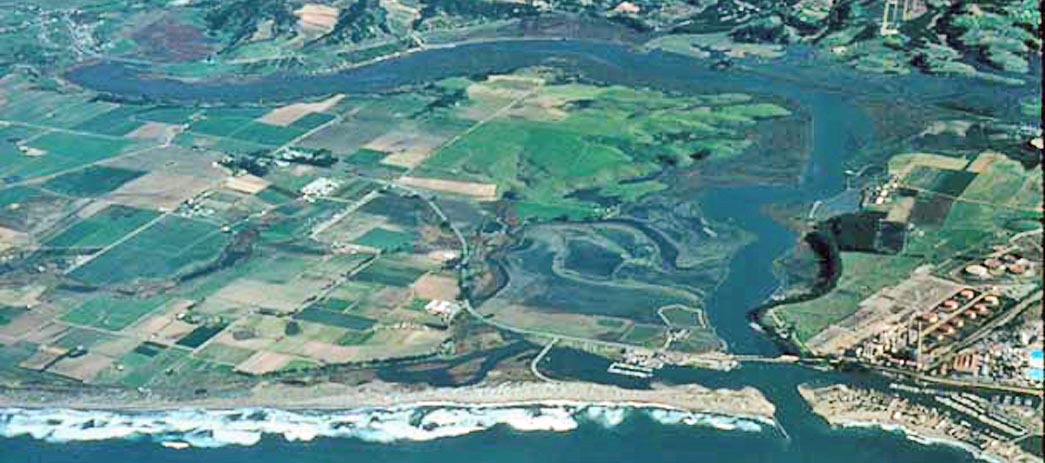 |
||
| The immediate vicinity of Moss Landing is just one slice of the birding opportunities here. The entire Elkhorn Slough is very birdy as it curves, crescent-shaped, to the north, between protected uplands and many agricultural fields (the aerial photo, above, is looking east from Monterey Bay, rather than oriented north, as are the maps. The aerial photo was taken at high tide.). This map from eBird shows 30 "hot spots" used by birders in the Elkhorn Slough vicinity of Monterey Co. (=MTY), and north to the Pajaro River mouth [plus 2 more in Santa Cruz Co. (=SCZ); the Pajaro River is generally the county line]. A few are not open to the public (e.g., Nature Conservancy property, or Moro Cojo Slough, although the latter can be scoped from Dolan Rd.), but most are accessible, and the better spots are mentioned below. | ||
 |
||
The entire Elkhorn Slough watershed is globally important. Much tidal area along the east side of the Slough is within Elkhorn Slough National Estuarine Research Reserve (Elkhorn Slough NERR; see below) and the Nature Conservancy obtained land north and west of the slough. California's Moss Landing Wildlife Area protects the old salt ponds just east of Hwy 1 and Moss Landing Harbor (together these areas are shown in dark green on the map, right). The non-profit Elkhorn Slough Foundation has protected much of Moro Cojo Slough and upland areas (light green on map). California State Parks operates Zmudowski State Beach, Moss Landing State Beach, and Salinas River State Beach, which protect the coastal dunes from the Pajaro River mouth to the Salinas River mouth. In birding Elkhorn Slough and the Moss Landing vicinity, it is not only important to be aware of the tides — and their effect on seeing shorebirds — but beware of cold coastal fog much of the summer, windy conditions in many afternoons, and the busy traffic on Highway 1 and, to a lesser extent, Dolan Road. Moss Landing harbor is easily accessible to all, but public access to the Slough itself is limited to a few points — primarily Elkhorn Slough NERR and Kirby Park in the upper reaches of the slough. Some of the best spots are: |
||
About half-way to the end of Jetty Road there is a standard gull roost at harbor's edge; views from the State Park are best in the afternoon. Western Gull nests here and is resident; California Gull is common but in summer numbers are reduced as breeders leave the area. The winter gull flocks are best from November-February, and regular species are Glaucous-winged (and various intergrades), Herring, Thayer's, and Ring-billed Gulls. Mew and Bonaparte's are less dependable. Forster's Terns are present most of the year in varying numbers; in summer Caspian Tern is common. Pigeon Guillemots nest around the harbor and can be seen in spring and summer just offshore or, sometimes, inside the harbor and even up Elkhorn Slough. Savannah Sparrow is resident in the salt marsh; "Nuttall's" White-crowned Sparrow breeds in the coastal dunes. At road's end there is a parking area and one can walk to the jetty on the north side of the harbor. The entire State Beach itself is full of birds -- gulls, terns diving offshore in season, shorebirds, flocks of Snowy Plover in season, and rarities such as Wilson's and Mongolian Plover have been with these flocks. Huge swirling flocks of Sooty Shearwaters can be just offshore in spring through fall; Common Murres and flocks of Western & Clark's Grebes are often present in winter. There is also public access just north of the bridge over Elkhorn Slough to a large parking area for restaurants [the most famous to birders was "Skipper's Restaurant" but it burned down 25 Ap 1998; a Sea Harvest Restaurant has now been built on the site] and the north harbor marina. From this parking area and the nearby boat ramp one has views of Moss Landing harbor and the gull roost directly across. A scope is needed to search the gull flock. Many rare species have visited this roost, including Swallow-tailed, Glaucous, Franklin's and Laughing Gulls. |
||
The operators of the pontoon boat also own and operate The Captain's Inn at Moss Landing, a lovely bed-and-breakfast right in 'downtown' Moss Landing itself. ° Moss Landing town and the South Jetty -- the town of Moss Landing is accessed off Highway 1 just south of the power plant and the bridge over Elkhorn Slough. A loop road goes through the tiny town (which is famous for antique stores) and connects back up with Highway 1 a short distance farther south (Moss Landing Marine Lab and a cemetery are along the south end of this loop). In the middle of town the only cross-street (Sandholt) heads past the Moss Landing marina (where one begins the Elkhorn Slough safari boat trip) and over a bridge to Moss Landing "island" (actually a thin peninsula that ends at the south jetty to Moss Landing harbor). There is a parking lot for the state beach at the north end of the bridge, and this lot, plus both ends of the bridge, given good views to other tidal areas of south Moss Landing harbor. [In fact, in crossing the bridge you are crossing the old Salinas River channel.] When tides and seasons are right, this area is great from shorebirds, grebes, ducks, and Brant. The paved road meanders through various ship-docking areas and shops and dead-ends at the South Jetty. Park here and walk the very short distance to the base of the jetty; bring a scope. Four species of loons (three regular, Yellow-billed very rare) have been found here, all the sea-ducks (including the very rare King Eider), all the grebes, and there is always a chance for alcids. Parasitic Jaegers sometimes chase Elegant Terns at the harbor mouth in fall. ° Potrero Road — at the south end of Moss Landing town, Potrero Road heads west and ends at another access point for the Salinas River State Beach. Right at the end the road crosses the old Salinas River channel again; this is another good shorebird area in season. The artichoke fields to the south are hunted by a wide selection of raptors in winter; these fields can also be viewed along Molera Road which loops through them and back to Highway 1 south of Castroville. |
||
 ° Moss Landing Wildlife Area
encompasses the old salt ponds on the inland (east) side of Highway 1,
just north of Elkhorn Slough. The ponds are controlled by tidal gates;
those near the Slough are sometimes good for roosting waders at high
tide, and may also be a major roost of Brown Pelicans. There is also a
Harbor Seal pupping area. The more northerly ponds are mostly kept dry
from an important breeding colony of endangered Snowy Plovers. Access
used to be through trails beginning at the northeast corner of the W.A.
but currently that access point and the trails are closed. Access is
now available through a gate portal (left) that includes explanatory
signs about the area, and that leads to a trail along Elkhorn Slough
itself for a short distance. A scope is often needed here to view the
dry ponds (on which terns roost in fall), the pelican roost area, and
the many happenings in the Slough (sea otters and sea ducks are
common). This access area is reached from Highway 1 just north of the
bridge over Elkhorn Slough through a short dirt road that is
sign-posted. Western Gulls routinely nest atop the gate portal (see
roof in the photo). ° Moss Landing Wildlife Area
encompasses the old salt ponds on the inland (east) side of Highway 1,
just north of Elkhorn Slough. The ponds are controlled by tidal gates;
those near the Slough are sometimes good for roosting waders at high
tide, and may also be a major roost of Brown Pelicans. There is also a
Harbor Seal pupping area. The more northerly ponds are mostly kept dry
from an important breeding colony of endangered Snowy Plovers. Access
used to be through trails beginning at the northeast corner of the W.A.
but currently that access point and the trails are closed. Access is
now available through a gate portal (left) that includes explanatory
signs about the area, and that leads to a trail along Elkhorn Slough
itself for a short distance. A scope is often needed here to view the
dry ponds (on which terns roost in fall), the pelican roost area, and
the many happenings in the Slough (sea otters and sea ducks are
common). This access area is reached from Highway 1 just north of the
bridge over Elkhorn Slough through a short dirt road that is
sign-posted. Western Gulls routinely nest atop the gate portal (see
roof in the photo). |
||
On the way in or out, along Struve Road near its intersection with Hwy 1, one can scope a portion of Bennetts Slough. This is a good spot in winter and spring for Ruddy Duck, Northern Shoveler, and (sometimes) Redhead or Canvasback. ° Pajaro River mouth — from Zmudowski SB parking lot one can walk the beach north for the half-mile to the Pajaro R. mouth which always has lots of roosting gulls, and many terns in summer (and various rarities over the years). Both sides of the Pajaro R. mouth are usually in Monterey County, but the Pajaro Dunes colony north of the river, and a short stretch of beach south, are within Santa Cruz County. The river mouth can also be accessed from Sunset SB in Santa Cruz Co. by walking the beach past the Pajaro Dunes colony, but that is a very long walk. |
||
Dolan Road and Castroville Blvd. both have views of Moro Cojo Slough (south of Dolan Road; Castroville Blvd. crosses the upper end of Moro Cojo Slough). Scopes are needed but the slough often has a wide variety of ducks and shorebirds. Dolan Road passes through cattle-grazing land, and sometimes Cattle Egrets are with cows in fall/winter. The swirling blackbird flocks usually have Tricoloreds and the occasional Yellow-headed Blackbird in May and again in fall. In recent years the fields south of Dolan Road, just opposite the entrance to Moonglow Dairy (Moonglow sign, right), have hosted flocks of hundreds of Canada Geese. In winter, these geese flocks attract rarer species: Greater White-fronted, both 'Aleutian' and 'Ridgway' Cackling, Snow, and Ross's Geese in small numbers. |
||
SEE A SEPARATE PAGE ON BIRDING AT MOONGLOW DAIRY The photo (below) shows part of the Dairy with the eucalyptus grove in the right-hand background, and the power plant in the background to the left. The cattle pens host the blackbird flocks. In recent years the slough-edge side of the eucalyptus grove has been the colonially breeding site for Great Blue Herons, Great Egrets, and Double-crested Cormorants. Please remember to be on your best behavior Moonglow Dairy. Read the rules on the separate page; park well away from dairy operations; and to drive slowly on the dirt roads. I feel a special responsibility here since none of us would have access but for the groundwork laid over 30 years ago |
||
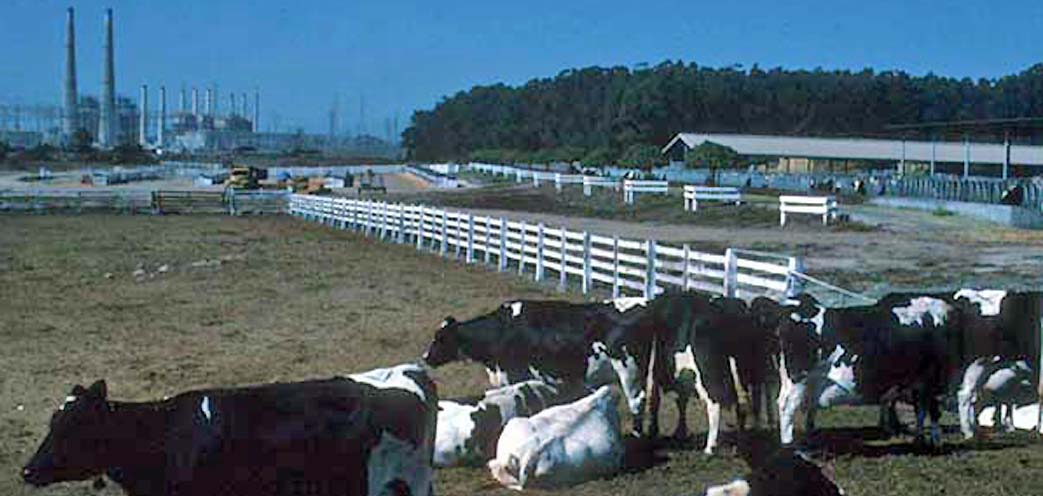 |
||
|
||
 ° Kirby Park and Elkhorn Road
— north of Elkhorn Slough NERR, Elkhorn Road follows the edge of
wetlands and is therefore lined with birds. A small wetland at the
intersection of Strawberry Road is a traditional site for the few
Lesser Yellowlegs that winter locally. Look also for flocks of wigeon
in winter; search them for the occasional Eurasian; or phalaropes (in
spring & fall). There is an overlook pullout about a mile north of
here to view Estrada Marsh (photo left) with lots of egrets and ducks,
and then comes the access road to Kirby Park. There is a lot of parking
adjacent to the Slough and a boat ramp. A boardwalk meanders north
along the Slough. Lots of rarities here over the years including
White-faced Ibis, Tufted Duck, and even Long-eared Owl (in the first
willow patch right of the boardwalk). When the tide is high, Common and
Red-throated Loons can be upslough to this point. There once was a
small population of Clapper Rail in the pickleweed here, but the rails
were extirpated by non-native Red Foxes in the 1980s. Farther north,
Elkhorn Slough crosses the upper end of Elkhorn Slough near a railroad
bridge, where you can scope both directions: the end of the Slough to
the west and Potter Marsh to the east. ° Kirby Park and Elkhorn Road
— north of Elkhorn Slough NERR, Elkhorn Road follows the edge of
wetlands and is therefore lined with birds. A small wetland at the
intersection of Strawberry Road is a traditional site for the few
Lesser Yellowlegs that winter locally. Look also for flocks of wigeon
in winter; search them for the occasional Eurasian; or phalaropes (in
spring & fall). There is an overlook pullout about a mile north of
here to view Estrada Marsh (photo left) with lots of egrets and ducks,
and then comes the access road to Kirby Park. There is a lot of parking
adjacent to the Slough and a boat ramp. A boardwalk meanders north
along the Slough. Lots of rarities here over the years including
White-faced Ibis, Tufted Duck, and even Long-eared Owl (in the first
willow patch right of the boardwalk). When the tide is high, Common and
Red-throated Loons can be upslough to this point. There once was a
small population of Clapper Rail in the pickleweed here, but the rails
were extirpated by non-native Red Foxes in the 1980s. Farther north,
Elkhorn Slough crosses the upper end of Elkhorn Slough near a railroad
bridge, where you can scope both directions: the end of the Slough to
the west and Potter Marsh to the east. |
||
 |
||
Elkhorn Slough itself is accessed by boat via Elkhorn Slough Safari pontoon boat trips which are led by naturalists (above). You can also join kayak trips up the Slough and around Moss Landing harbor (right). Out-of-towners may obtain private tours from Elkhorn Slough area resident Rick Fournier at Monterey Birding Adventures (for a fee). Also see the separate photo page on MoonGlow Dairy.
Literature cited:
Acknowledgments: I thank Rita Carratello, Steve Bailey, Todd Newberry, Steve Rovell, and Roger Wolfe for comments on an earlier version of this page. I also thank Mark Silberstein for permission to use his aerial photo of Elkhorn Slough and Moss Landing harbor. The remaining photos are mine. |
||
|
TOP |
all photos & text © Don Roberson |
back to HOME |
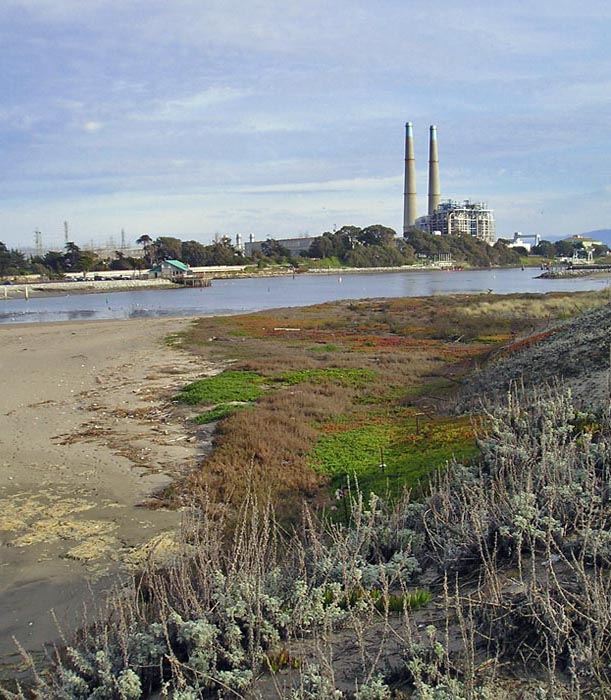
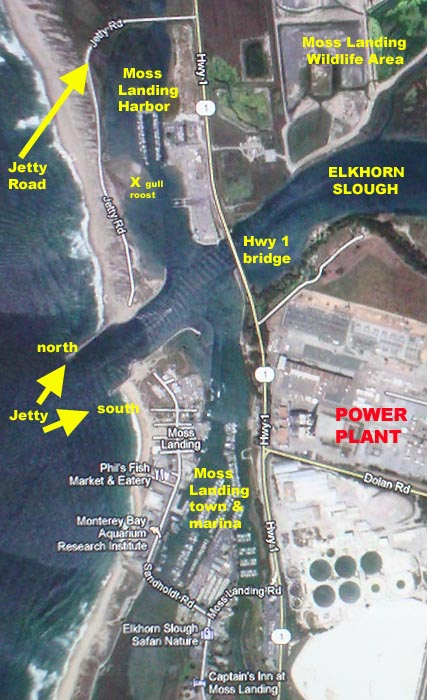
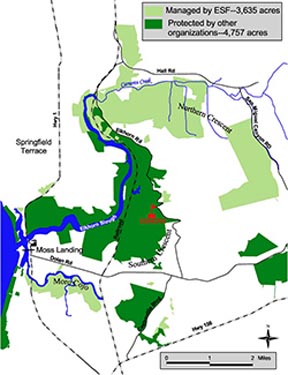 Elkhorn
Slough is a principal staging and feeding area for migratory
shorebirds. It is located right in the center of the curve of Monterey
Bay and drains directly into the Pacific Ocean through the Moss Landing
harbor channel. Before the channel was created (1946) and the rivers
diverted (1908-1910), the Salinas River ran north from its present
mouth to its old original mouth north of today's Moss Landing. Today's
Moss Landing harbor and various sloughs to the south are part of this
old river bed. The Monterey Bay Aquarium has published a fine
introductory guide to Elkhorn Slough by Mark Silberstein and Eileen
Campbell (1989). I can offer only a few highlights here directed to the
field birder (more details are published in Roberson 2002).
Elkhorn
Slough is a principal staging and feeding area for migratory
shorebirds. It is located right in the center of the curve of Monterey
Bay and drains directly into the Pacific Ocean through the Moss Landing
harbor channel. Before the channel was created (1946) and the rivers
diverted (1908-1910), the Salinas River ran north from its present
mouth to its old original mouth north of today's Moss Landing. Today's
Moss Landing harbor and various sloughs to the south are part of this
old river bed. The Monterey Bay Aquarium has published a fine
introductory guide to Elkhorn Slough by Mark Silberstein and Eileen
Campbell (1989). I can offer only a few highlights here directed to the
field birder (more details are published in Roberson 2002).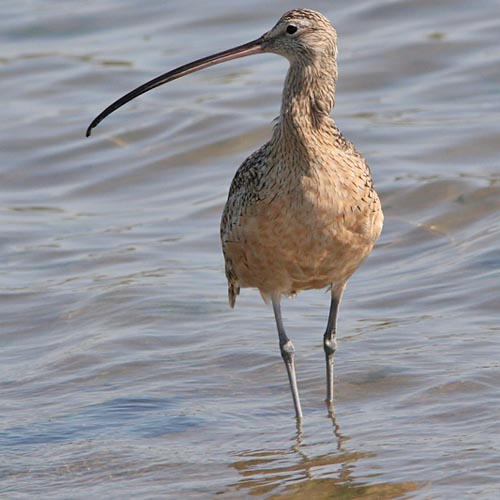 ° Jetty Road:
This paved road leaves Hwy 1 a half-mile north of the Hwy 1 bridge over
Elkhorn Slough, and continues .75 mi to a dirt parking area at the base
of the north jetty. There are several pull-offs/parking areas with
portable toilets. Sometimes the wind blows sand across the road and the
road can be closed for some time. A tidal gate under the road near the
entrance lets the tide run either way, and whether there are mudflats
(and waders, like Long-billed Curlew, left) or salt water depends on
the tide. Migratory shorebirds are usually around in good numbers (at
the right tide) except in June, when only a few stragglers are left. In
winter, flocks of scoters (mostly Surf), scaup (mostly Greater), and
Bufflehead enjoy the harbor. Scarcer but regular species include Brant,
Common Goldeneye, Long-tailed Duck or Harlequin Duck. All 3 cormorants
are resident. In winter, all 3 loons may be present, as well as Eared,
Horned, Western, Clark's and a very few Red-necked Grebes. Great Blue
Heron and both egrets are resident. Numbers of Brown Pelicans,
Heermann's Gulls, and Elegant Terns appear from July to October, with
numbers dwindling after that. A few American White Pelican can be
present at any date. The standard migrant and winter shorebirds are
Black-bellied and Semipalmated Plovers, Willet, Marbled Godwit,
Long-billed Curlew, Western & Least Sandpipers, Dunlin, and both
dowitchers (although Short-billeds use the tidal mudflats more than
Long-billeds, which are more common up-slough). The sandy shore or salt
ponds have resident Snowy Plover (some areas are closed off for their
nesting); Sanderlings run along the waves most of the year. In spring
and fall migration look for Ruddy Turnstone and Red Knot.
° Jetty Road:
This paved road leaves Hwy 1 a half-mile north of the Hwy 1 bridge over
Elkhorn Slough, and continues .75 mi to a dirt parking area at the base
of the north jetty. There are several pull-offs/parking areas with
portable toilets. Sometimes the wind blows sand across the road and the
road can be closed for some time. A tidal gate under the road near the
entrance lets the tide run either way, and whether there are mudflats
(and waders, like Long-billed Curlew, left) or salt water depends on
the tide. Migratory shorebirds are usually around in good numbers (at
the right tide) except in June, when only a few stragglers are left. In
winter, flocks of scoters (mostly Surf), scaup (mostly Greater), and
Bufflehead enjoy the harbor. Scarcer but regular species include Brant,
Common Goldeneye, Long-tailed Duck or Harlequin Duck. All 3 cormorants
are resident. In winter, all 3 loons may be present, as well as Eared,
Horned, Western, Clark's and a very few Red-necked Grebes. Great Blue
Heron and both egrets are resident. Numbers of Brown Pelicans,
Heermann's Gulls, and Elegant Terns appear from July to October, with
numbers dwindling after that. A few American White Pelican can be
present at any date. The standard migrant and winter shorebirds are
Black-bellied and Semipalmated Plovers, Willet, Marbled Godwit,
Long-billed Curlew, Western & Least Sandpipers, Dunlin, and both
dowitchers (although Short-billeds use the tidal mudflats more than
Long-billeds, which are more common up-slough). The sandy shore or salt
ponds have resident Snowy Plover (some areas are closed off for their
nesting); Sanderlings run along the waves most of the year. In spring
and fall migration look for Ruddy Turnstone and Red Knot. 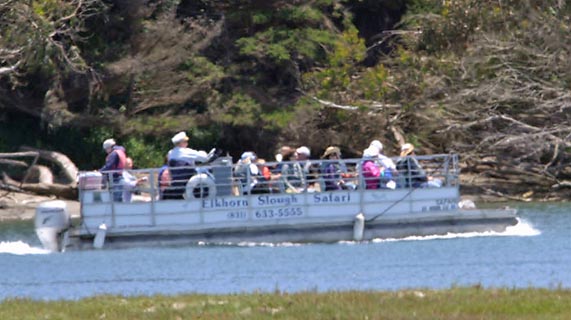 ° Elkhorn Slough pontoon boat: Another great way to bird the area is from the
° Elkhorn Slough pontoon boat: Another great way to bird the area is from the 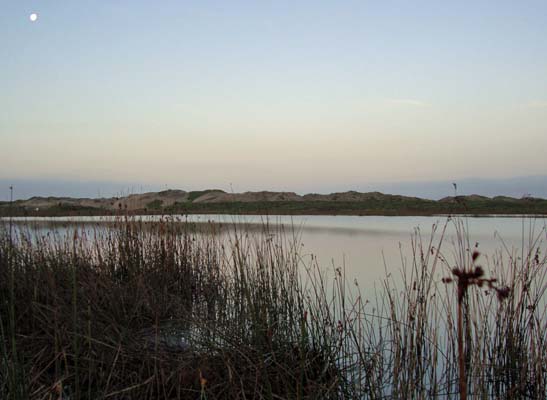 ° Zmudowski State Beach
— another good waterbird area with a freshwater pond and reedy edge is
north of Jetty Road. Just north of Jetty Road the highway turns back
east for a short distance and Struve Road exits to the left. Take
Struve to the first left (Giberson) and follow that zig-zagging paved
road to Zmudowski SB at the end (there are signs; the road does
deteriorate near the end). There is a freshwater pond just before the
end of the road where many interesting ducks and other rarities (Little
Gull, White-faced Ibis) have occurred. American Bitterns, Snowy Egrets,
Black-crowned Night-herons and rails have bred in the reeds at the
north end of the pond (no access to the site). Marsh Wrens are resident
in the reeds [Do be aware there have been some car break-ins at the
Zmudowski SB parking lot in the past.] Photo (right) shows Zmudowski
pond at dawn, looking toward the coastal sand dunes.
° Zmudowski State Beach
— another good waterbird area with a freshwater pond and reedy edge is
north of Jetty Road. Just north of Jetty Road the highway turns back
east for a short distance and Struve Road exits to the left. Take
Struve to the first left (Giberson) and follow that zig-zagging paved
road to Zmudowski SB at the end (there are signs; the road does
deteriorate near the end). There is a freshwater pond just before the
end of the road where many interesting ducks and other rarities (Little
Gull, White-faced Ibis) have occurred. American Bitterns, Snowy Egrets,
Black-crowned Night-herons and rails have bred in the reeds at the
north end of the pond (no access to the site). Marsh Wrens are resident
in the reeds [Do be aware there have been some car break-ins at the
Zmudowski SB parking lot in the past.] Photo (right) shows Zmudowski
pond at dawn, looking toward the coastal sand dunes.  ° Dolan Road fields
— Dolan Rd. goes inland from Hwy 1 at the Moss Landing power plant.
Elkhorn Road intersects it about 3 miles inland; one follows Elkhorn
Road north (left) to reach Elkhorn Slough NERR and the upper end of
Elkhorn Slough. Just before (west) of Elkhorn Road, Castroville Blvd.
goes south (right) and connects with Highway 156 near Castroville.
° Dolan Road fields
— Dolan Rd. goes inland from Hwy 1 at the Moss Landing power plant.
Elkhorn Road intersects it about 3 miles inland; one follows Elkhorn
Road north (left) to reach Elkhorn Slough NERR and the upper end of
Elkhorn Slough. Just before (west) of Elkhorn Road, Castroville Blvd.
goes south (right) and connects with Highway 156 near Castroville. 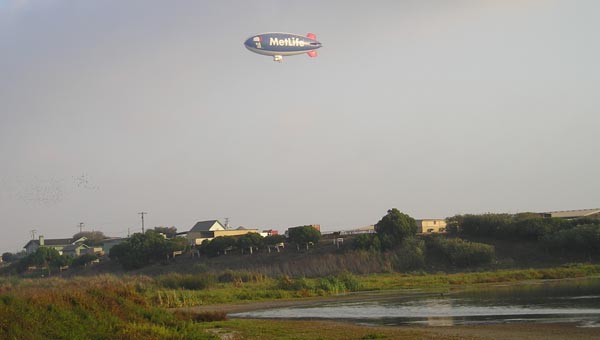 ° MoonGlow Dairy
— for avid birders there may be no better spot in the entire area than
the privately owned MoonGlow Dairy (in the photo left, a blimp passes
over Moonglow Diary; a freshwater pond is in the right foreground).
From the Dairy there are fabulous views of Elkhorn Slough (a scope
needed), a freshwater pond next to the Slough, and the State's best
eucalyptus grove. It is located 1.2 miles east of Highway 1 off Dolan
Road. I was first able to arrange birding access here about 1980, and
the owners — Louis & Carol Calcagno — have welcomed birders ever
since. However, this is an active dairy operation and there are
important rules you must know before birding here. It is the active
operation of the dairy that attracts huge flocks of blackbirds
(Tricoloreds in huge numbers except in spring when they return to
breeding colonies), and it is the dairy's active management of the
freshwater pond that creates duck habitat in winter/spring and
shorebird habitat in fall. The pond is the single best freshwater pond
in Monterey County and it would not exist except for the dairy. It is
one of the most important resources on the Slough.
° MoonGlow Dairy
— for avid birders there may be no better spot in the entire area than
the privately owned MoonGlow Dairy (in the photo left, a blimp passes
over Moonglow Diary; a freshwater pond is in the right foreground).
From the Dairy there are fabulous views of Elkhorn Slough (a scope
needed), a freshwater pond next to the Slough, and the State's best
eucalyptus grove. It is located 1.2 miles east of Highway 1 off Dolan
Road. I was first able to arrange birding access here about 1980, and
the owners — Louis & Carol Calcagno — have welcomed birders ever
since. However, this is an active dairy operation and there are
important rules you must know before birding here. It is the active
operation of the dairy that attracts huge flocks of blackbirds
(Tricoloreds in huge numbers except in spring when they return to
breeding colonies), and it is the dairy's active management of the
freshwater pond that creates duck habitat in winter/spring and
shorebird habitat in fall. The pond is the single best freshwater pond
in Monterey County and it would not exist except for the dairy. It is
one of the most important resources on the Slough.  ° Elkhorn Slough NERR — Elkhorn Slough NERR is open to the public daily 9 a.m.-5 p.m. Wednesday through Sunday (but double-check
° Elkhorn Slough NERR — Elkhorn Slough NERR is open to the public daily 9 a.m.-5 p.m. Wednesday through Sunday (but double-check 